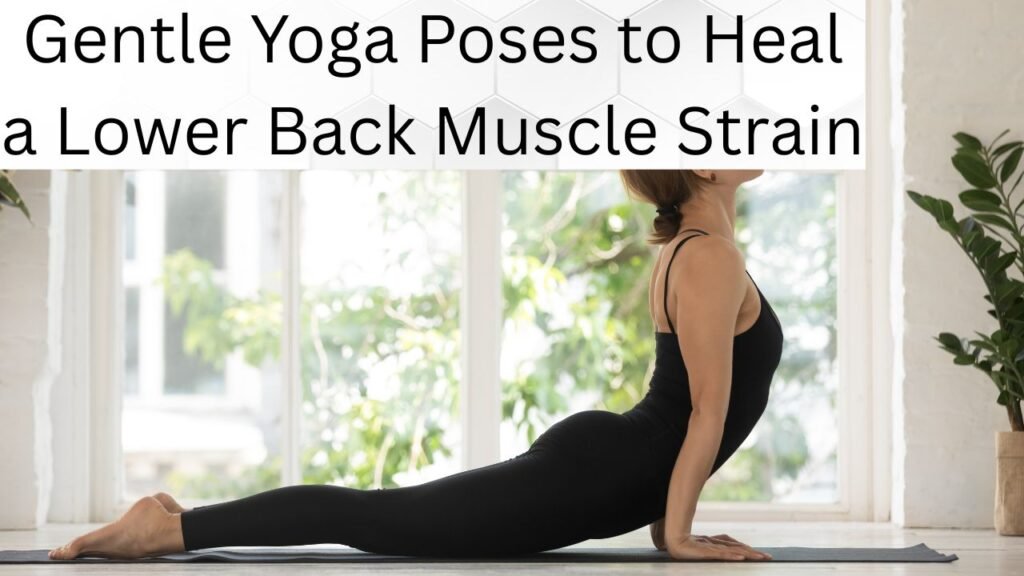Lower back muscle strains are common, often caused by poor posture, sudden movements, or overuse. While rest is essential, movement plays a key role in recovery. Yoga provides gentle, controlled stretches that promote blood flow, relieve tension, and strengthen muscles. Practicing the right yoga poses can help speed up healing and prevent future injuries.

Understanding Lower Back Strains
A muscle strain happens when fibers in the muscle or tendon stretch or tear due to excessive force. Symptoms include stiffness, pain, muscle spasms, and limited mobility. Unlike more severe back injuries, such as herniated discs, muscle strains typically heal within a few weeks with proper care. Yoga helps by increasing flexibility, improving circulation, and gradually rebuilding strength in affected areas.
Precautions Before Starting Yoga
Before practicing yoga for lower back strain relief, keep these precautions in mind:
- Listen to Your Body: If a pose increases pain or discomfort, modify or skip it.
- Move Slowly: Avoid sudden movements that can worsen the injury.
- Focus on Breathwork: Deep breathing enhances relaxation and promotes healing.
- Avoid Overstretching: Gentle, gradual movements are more effective than forcing a stretch.
Best Gentle Yoga Poses for Lower Back Muscle Strains
These beginner-friendly poses provide a safe and effective way to ease pain and encourage recovery.
1. Child’s Pose (Balasana)
Why it helps: This pose gently stretches the lower back, hips, and spine, promoting relaxation.
How to do it:
- Kneel on the floor with your big toes touching and knees spread apart.
- Sit back onto your heels and extend your arms forward.
- Lower your chest toward the mat, resting your forehead down.
- Hold for 30 seconds to 1 minute while breathing deeply.
2. Cat-Cow Stretch (Marjaryasana-Bitilasana)
Why it helps: This movement increases spinal mobility, reduces stiffness, and improves circulation in the back muscles.
How to do it:
- Start on hands and knees in a tabletop position.
- Inhale, arch your back, drop your belly, and lift your head (Cow Pose).
- Exhale, round your back, tuck your chin, and draw your belly in (Cat Pose).
- Repeat slowly for 8-10 breaths.
3. Supine Knee-to-Chest Stretch
Why it helps: This pose gently stretches the lower back, relieving tension and improving mobility.
How to do it:
- Lie on your back with your legs extended.
- Bend one knee and bring it toward your chest.
- Hold the knee with both hands and gently pull it closer.
- Hold for 20-30 seconds, then switch legs.
4. Seated Forward Fold (Paschimottanasana)
Why it helps: This stretch releases tension in the lower back and hamstrings, which can contribute to pain.
How to do it:
- Sit with legs extended straight in front of you.
- Inhale, lengthen your spine, and exhale as you hinge at the hips to reach forward.
- Hold onto your shins, ankles, or feet without forcing the stretch.
- Stay for 20-30 seconds, breathing deeply.
5. Sphinx Pose
Why it helps: This gentle backbend strengthens the lower back while improving spinal support and flexibility.
How to do it:
- Lie on your stomach with your legs extended and elbows under your shoulders.
- Press your forearms into the mat and lift your chest slightly.
- Keep your hips and legs relaxed.
- Hold for 30 seconds, breathing steadily.
6. Reclining Twist (Supta Matsyendrasana)
Why it helps: This pose relieves lower back stiffness and gently stretches spinal muscles.
How to do it:
- Lie on your back with knees bent and feet flat.
- Drop your knees to one side while keeping shoulders on the mat.
- Extend your opposite arm outward and turn your head toward it.
- Hold for 20-30 seconds before switching sides.
7. Bridge Pose (Setu Bandhasana)
Why it helps: This pose strengthens the glutes, lower back, and core, which support spinal stability.
How to do it:
- Lie on your back with knees bent and feet hip-width apart.
- Press into your feet and lift your hips while keeping your shoulders grounded.
- Hold for 20-30 seconds, then slowly lower down.
Additional Tips for Faster Recovery
- Apply Heat or Ice: Use ice packs in the first 48 hours to reduce inflammation, then switch to heat therapy.
- Stay Hydrated: Proper hydration supports muscle recovery.
- Maintain Good Posture: Sitting with proper alignment prevents further strain.
- Strengthen Core Muscles: A strong core reduces pressure on the lower back.
When to Seek Professional Help
If pain persists for more than a few weeks, worsens, or spreads to other areas, consult a healthcare provider. Yoga is a supportive tool but should not replace professional medical advice for severe injuries.
Conclusion
Yoga offers a gentle and effective way to heal lower back muscle strains. By practicing these poses with mindfulness and consistency, you can ease discomfort, improve flexibility, and strengthen your back. Pair your yoga routine with healthy lifestyle habits to ensure long-term spinal health and prevent future injuries.